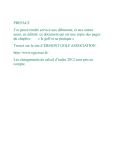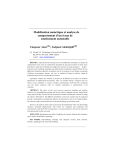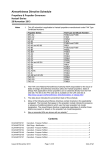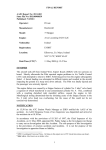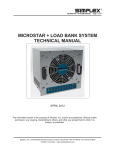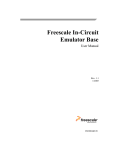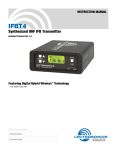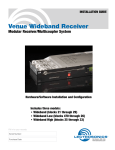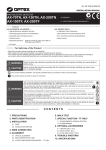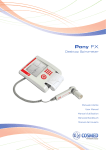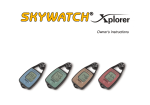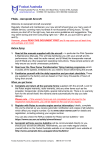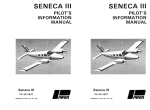Download AAIU Report No
Transcript
AAIU Report No.:2002/012 AAIU File No.: 2000/0027 Published Date: 11/10/02 Operator: Aerial Advertising Limited Manufacturer: Piper Model: PA-34-200 T Nationality: Irish Registration: EI-EIO Location: Dublin Airport. Runway 11/29 Date/Time (UTC): 6 May 2000; 1612 hours SYNOPSIS. Shortly after touchdown at a local military airfield, the right main gear started to collapse. The commander then applied full power and pushed the control wheel to the left to level the aircraft. After lift-off the crew noted that the right main gear light had gone out and that the red warning light (“gear unsafe”) had come on. Recycling the undercarriage, and attempting to drop it using the emergency extension system, did not change this condition. The military personnel on the ground confirmed that the right main undercarriage appeared to them to be half retracted and after some time the commander decided to divert to RWY 11 at Dublin Airport. An emergency was then declared. The commander managed to hold the wing up off the ground until late in the landing run. As the lift on the starboard wing decreased the undercarriage on that side collapsed outwards. The aircraft slid to the right and stopped on the runway edge. The crew were uninjured and exited through the right hand door. Notification of the incident was made to the Air Accident Investigation Unit by the Aer Rianta Duty Officer at Dublin Airport. Mr. Kevin Humphreys, the Chief Inspector of Accidents, and Mr. J Hughes, Inspector of Accidents, visited Dublin Airport and initiated an investigation into the occurrence. 1. FACTUAL INFORMATION 1.1 History of the Flight. The flight took off from Weston at 14.42 hours in order to do circuit training at a local military airfield 2 nm distant. The commander was acting as a Flight Instructor for the purpose of this flight. The student made an initial approach on to RWY 11/29. The commander said that the three green indicating lights, signalling that all three undercarriage struts were down and locked, were confirmed as “ON”. 11/10/02 Shortly after touchdown, the starboard main undercarriage gear started to collapse. The commander applied full power and rolled the control wheel to the left to level the aircraft. The aircraft lifted off. He said that after lift-off, he noted that the starboard green indicating light had gone out and that the red gear warning light had illuminated indicting that one of the undercarriage struts was no longer locked down. The military ATC personnel were then informed of the problem. Their ATC log states that “after the first T & G (touch and go) the pilot reported that he heard an unusual sound from the undercarriage”. The undercarriage gear was recycled. The student, who could see the nose undercarriage through the mirror on the left nacelle, said that the nose undercarriage did not fully retract during recycling. After flying past the control tower, ATC confirmed that the starboard leg appeared to be only half retracted. Attempts were made to shake the gear down by applying G forces. Finally, the emergency gear extension was used. (The emergency gear extension merely releases hydraulic pressure to allow the gear to free-fall.) All attempts failed to extinguish the red warning light and to illuminate the starboard green light. The commander noticed a slight glint from the top of the propeller arc. The aircraft circled the airfield with the student handling the aircraft whilst the commander carried out checks. He said that as the red light could indicate a continuously running hydraulic pump he pulled the appropriate circuit breaker until reaching the final approach. He also cross-fed the port engine from the starboard tank to reduce the fuel weight on that side. As the student checked for security of cabin items, the commander briefed her on the choice of exit on landing. The commander decided to burn off some fuel prior to his intention to make an emergency landing at the airfield. After circling for about one hour, and following a discussion with the aircraft’s operator, the commander decided to divert to Dublin Airport, 9 miles away. The military ATC handed over the aircraft to Dublin ATC at 16.08 hrs. An emergency was declared, a flapless approach decided, and with all electrics, fuel and magnetos turned off just before the flare, the aircraft made a landing on Rwy 11. The commander managed to hold the starboard wing up until late into the ground run. When finally the lift on the wing reduced, the starboard undercarriage collapsed. When the wing settled, the aircraft swung and ran partly off the edge of the runway. Dublin ATC informed the military ATC that as soon as the aircraft slowed down on the runway at Dublin Airport the starboard wheel “buckled”. The crew were uninjured and exited through the right door. The time was 16.24 hrs. Examination of the starboard engine propeller showed the tips of the blades to be bent forward and the starboard undercarriage to have collapsed outwards. 1.1.1 Commander’s Report. The commander said that the undercarriage warning horn did not come on at any time during the flight. He said this would only come on if the gear had not been selected down and the throttle was brought back so that the manifold pressure was below approximately 14 inches of Mercury. 2 He indicated that, on lowering the undercarriage, the manifold pressure would normally be well above this value so that the warning horn would not sound nor would the red gear light come on at this time. He again said that prior to the initial landing “the undercarriage was confirmed down and locked by three greens” The commander said that the landing and touchdown were considered normal prior to the collapse of the starboard undercarriage. He did not consider it to be a hard landing. He considered that the “unusual sound from the undercarriage” emanated from the blade tips touching the runway surface. 1.1.2 Student’s Report The student said that she had a CPL with approximately 350 hours flying experience with 10 hours on type. She said that on the approach to land, she throttled back prior to selecting the gear down. She selected gear down. The red gear warning light (“gear in transit”) illuminated as normal. The light went out. She confirmed that she had three green undercarriage lights indicating that the gear was down and locked. She said that shortly after touchdown, the right main gear began to collapse. The instructor then took over the control of the aircraft. The student also said that during the numerous attempts at recycling the undercarriage she noticed that the nose gear, which she could see through a mirror, did not fully retract on any of these attempts. On final approach to Runway 11 at Dublin Airport she turned off all the electrics, and just before the flare, pulled the fuel mixture control to idle-cut off and turned the fuel and magnetos off. 1.1.3 Witness Reports A military Aeronautical Engineer, on duty in Baldonnel, said that he had watched the aircraft circle over the aerodrome. He did not observe the position of the nose wheel but said that the starboard undercarriage leg was only half extended, in its normal arc, and was at less than 45° to the plane of the wing. The leg was in this position when the aircraft diverted to Dublin Airport. The ATC personnel at Dublin Airport could not recall the exact position of the starboard leg on the approach to RWY 11. 1.1.4. Owner’s Report The owner made two comments as follows: (a) “All aircraft on occasions do, and the Seneca in particular does, on initial selection of the undercarriage to the down position can have a gear unsafe light on and two greens visible. When recycled three greens appear and the gear unsafe light goes out”. 3 (b) “When seated in the right hand seat the right undercarriage green light is not readily visible to the instructor whereas the nose and port light are. When this condition exists and bright sunlight is shining into the cockpit it will confuse the interpretation of the red unsafe light.” 1.2 Injuries To Persons There were no injuries reported to the investigation. 1.3 Damage To Aircraft There was extensive damage to the starboard undercarriage retraction mechanism. Most of the lower side brace link had broken off but part of it remained screwed into the rod end bearing. The remainder, along with a down-limit micro switch was hanging from the leg by the micro switch wiring. The upper side brace link was ruptured and bent at an angle of 10° in the horizontal plane where it joined with the lower side brace link (see Appendix A). The rupture of the lower side brace link at the rodend exhibited a corresponding 10° bending fracture (see Appendix B). The hydraulic piston retraction fitting on the upper side brace had bent rearwards and had fractured. The rod end bearing which joined the linkages to the undercarriage leg remained attached to the leg. The starboard propeller had made contact with the ground shortly after the initial touchdown and both blade tips were bent forwards. A Licensed Engineers Report Concluded: “Inspection of PA 34-200T Seneca registration EI-EIO found damage was concentrated around the starboard landing gear area with any impact loading being received by both starboard main trunnion bracket and bearing release. Other damage in this area is associated with the landing gear coming into contact with airframe parts. A symmetry check found no signs of airframe warping including engine frames. Propeller damage was minimal on the starboard engine. The starboard aileron bracket prevented damage to starboard wing tip and skins. Slight metal removal of this bracket was evident but no structural damage was imparted to the bracket. The tail tie down bracket also acted in a similar manner for the empennage and the cabin step has broken off.” 1.4 Other Damage There was no other damage. 4 1.5 1.5.1 Personnel Information PNF (Commander) Personal Details Licence Last Periodic Check Medical Certificate ATPL 3 July 1999 23 March 2000 Flying Experience: Total all types Total all types PI Total on type Total on type PI Last 90 days Last 28 days Last 24 hours 1.5.2 6596 6324 90 79 65 39 2 hours hours hours hours hours hours hours PF (Pilot Under Training) Personal Details Licence Last Periodic Check Medical Certificate CPL 13 October 1999 27 September 1999 Flying Experience: Total all types Total all types PI Total on type Total on type PI Last 90 days Last 28 days Last 24 hours 1.6 357 240 12 Nil 10 7 Nil hours hours hours hours hours hours hours Aircraft Information Aircraft type PA- 34 – 200 T Manufacturer Piper Constructor’s number 34-7670274 Year of manufacturer 1976 Engine Type TSIO-360-E Engine Serial No. L/H 303622. Propeller Type BHC.C2YF.2 CLKUF Propeller Serial No. L/H - AN2650. R/H- AN2616 5 R/H 304643 1.6.1 Undercarriage System This seven-seat PA-34-2000T airplane is equipped with a retractable tricycle air-oil strut type landing gear, hydraulically raised or extended by an electrically powered reversible pump (see Appendix C). A selector switch in the instrument panel to the left of the control quadrant is used to select gear UP or DOWN position. The selector must be pulled out before it is moved to the UP or DOWN position. Gear extension or retraction normally takes six to seven seconds. The nose gear also uses aerodynamic extension forces (air flow aiding gear extension), has a different weight and actuator control arm to the main gear. To ensure the proper sequencing and timing of the nose gear versus the main gear retraction and extension actions, restrictors are installed in the hydraulic lines to and from the nose gear actuator. 1.6.1.1 Undercarriage Warning System Gear positions are indicated by three green lights directly above the selector switch when the gear is down and locked, and a red light at the top of the instrument panel when gear is unsafe. Activation of all three down-lock switches will shut the hydraulic pump off. As the instrument lights are turned on, the green lights will dim. When the throttle is sufficiently retarded and the landing gear has not been extended, a throttle switch, located in the quadrant will actuate a warning horn and the above red light, indicating to the pilot that the landing gear is still up. The warning horn will continue to operate, and the red light illuminate, until the landing gear is down and locked, at which time three green lights on the instrument panel will energize. It is normal that the landing gear be extended and retracted by means of the gear selector knob. However, in the event of hydraulic or electrical failure, the gear can be extended by pulling the free-fall valve thus permitting the gear to fall free. The nose and main gear require no assist springs. Once the gear is down and the down-lock hooks engage, a spring maintains pressure on each hook in the locked position until released by hydraulic pressure. The gear down limit switch is mounted on a bracket attached to the lower drag link of each main gear. The switch should be adjusted to allow it to actuate when the downlock hook has entered the locked position and is within .025 to .035 inch of contacting the pin thus turning the green light on in the cockpit. 1.6.2 Manufacturers Instructions (a) LANDING GEAR UNSAFE WARNINGS ( Seneca II Flight Manual, July 1974) The red landing gear light will illuminate when the landing gear is in transition between the full up position and the down and locked position. The pilot should recycle the landing gear if continued illumination of the light occurs. Additionally the light will illuminate when the gear warning horn sounds. The gear warning horn will sound at low throttle setting if the gear is not down and locked. 6 (b) Approach and Landing (Seneca Π Operating Instructions 1975) Sometime during the approach for a landing, the throttle controls should be retarded to check the gear warning horn. (c) GEAR-UP EMERGENCY LANDING( Seneca II Service Manual,March 1984) a. Approach with power at a normal airspeed. b. Leave flaps up (to reduce wing and flap damage). c. Close the throttles just before touchdown. d. Turn off the master and ignition switches. e. Turn fuel selector valves to ‘OFF’. f. Contact the surface at minimum airspeed. 1.6.3 Aircraft Servicing An Annual inspection prior to a C of A renewal was carried out in March 1996 when the airframe had a total of 4164 hours. During this inspection the whole undercarriage was removed, cleaned, inspected and items for refitting were repainted. The main undercarriage trunnion houses were replaced in accordance with Service Bulletin No. 787B. The undercarriage squat switch was also replaced. Overhauled propellers were fitted on 31 July 1998 at 982 engine hours. A 150hour inspection in accordance with CAA/LAMS/A/1999 issue 1 was carried out on 25 March 2000. This schedule includes an inspection of:Undercarriage structural members, attachment fittings, pivot points, shock absorbers and torque links. The inspection also included an aircraft undercarriage retraction test and lubrication in accordance with the aircraft service manual. The port brake pads and port main tyre were replaced at this time. A 50 hour inspection was carried out on 14 April 2000 in accordance with the above schedule which includes an inspection of :Landing gear assemblies, shock-absorbing struts and their correct extension, brake system, lining, discs, wheels and tyres. On 3 May 2000 the port main tyre burst on landing. The tyre and tube were replaced and an inspection carried out as follows:Inspection of wheel and brake assemblies-found satisfactory. Inspection of undercarriage-found satisfactory. Another 50 hour inspection had been carried out on the 5 May 2000 (the day before the accident). The worksheets indicate that;the undercarriage system had been lubricated, the landing gear assemblies had been inspected, and that the leg struts had been checked for correct extension. The undercarriage power pack, which controls hydraulic oil pressure to the cylinders, was topped up with oil. The last recorded airframe hours on 5 May 2000 was 5338.72 hours. 7 1.7 Meteorological Information 1.7.1 Weather Weather report for the Baldonnel/Dublin area for 1430 to 1600 UTC 6 May 2001 General Situation: Wind: At surface: 070-090/08-12kt At 2000 ft: 09012kt Weather: Risk isolated patches light rain Visibility: 10+ kilometres Cloud: FEW 2200ft BKN 5000 to 6000ft Temperature/DewPoint: Temperature: 11° Celsius, Dew Point: 02 to 04° Celsius MSL Pressure: 1031 hPa Sunshine: 1.8 A large anticyclone anchored off the west-northwest coast of Ireland maintained a east to northeast airflow over the area. At 15.00 hrs, 1.0 hours of sunshine were recorded in the previous hour. Aids to Navigation Not applicable 1.9 Communications Following the airborne undercarriage checks, Baldonnel ATC arranged for the operating company to talk to the commander directly and after a discussion of the problem it was decided to divert to Dublin Airport. 1.10 Aerodrome Information RWY 11/29 at Dublin Airport is an asphalt/concrete runway of 1357 metres in length and is 61 metres wide. 1.11 Flight Recorders No flight recorders were installed nor were they required. 1.12 Wreckage and Impact Information All parts of the broken undercarriage retraction mechanism were eventually recovered. The aircraft was intact on landing with no damage to the runway surface either at the military airfield or Runway 11/29 at Dublin Airport. 8 1.13 Medical Information Not Applicable 1.14 Fire There was no fire 1.15 Survival Aspects The student was briefed by the commander prior to landing on the precautions to be taken during landing including the need to use the rear door in the event of fire or fuel spillage. As it turned out, as there was no fire, both occupants undid their lap-and– diagonal seat harnesses and exited the aircraft using the right hand door. 1.16 Tests and Research The broken parts of the undercarriage retraction/extension mechanism were sent to a laboratory for analysis. Photos of these parts are shown in Appendix A to this report. The examination concludes: “The fracture surfaces at (1) and (2) were bright/fibrous and were stated to be typical of overload failure. The fracture surface at (3) was also bright and typical of overload failures. There was considerable localised distortion associated with the failures at (2) and (3)” The final comments were: · The mode of failure at the three fracture sites is that of ductile overload. · The bright fracture features (with no indication of a pre-existing defect) suggests that the above fractures occurred in the same incident. The fracture at (2) on the triangular upper side brace link shows bright marks on the inside of the housing where the bushing would normally be fitted. The forward side of the housing was torn away and there is evidence of bending and distortion of the housing from compressive forces acting towards the rear of the wheel well. The fracture at (3) also shows bending with the threads on the retraction fitting showing compression on one side. The fitting is distorted towards the rear of the wheel well. The fractured bolt at the rod end was also sent for analysis. With reference to Appendix B the laboratories comments on this 12 mm bolt was as follows: “Fracture in the rod end has occurred through ductile overload. There was bending associated with the fracture, possibly resulting from compressive loads. There was no indication of any material or manufacturing defect, or of any pre-existing, in-service defect such as fatigue cracking. 9 Hardness tests carried out on the rod yielded values of 329 to 337 Vickers (HV/30). These values are typical of a strength grade 10.9 bolt, which would have a minimum tensile strength of 1040 N/mm² This would approximate to a minimum breaking load of 117700 N (~ 11.9 tonf) for a 12 mm diameter rod, in tension. The load necessary to cause failure could be considerably lower in bending.” The micro switch attached to the lower link (Appendix A) was examined and electrically tested. It was found serviceable. The damaged upper and lower links were assembled together. In a test, it was confirmed that the micro switch polarity changes as the down-lock hook comes into place. On the aircraft, this change of polarity illuminates the green light, thus confirming that the undercarriage leg is down and locked. 1.16.1 Manufacturers Comment The manufacturers said that there were no other reports concerning similar incidents where the PA34-200 T main landing gear down lock link had failed independently. They stated that the landing gears were side-loaded to extremes during development and testing for certification and should not exhibit this type of failure. They speculated that adjustment of components and/or corrosion may have played a part in this incident. 2. ANALYSIS The Commander and his student both confirm that the three green lights were obtained prior to touchdown. If this was the case then the main and nose undercarriages were confirmed “down and locked”. In such a case the impact forces on touchdown would act in an almost vertical direction through the trunnion supporting the right leg. This force would have to be considerable to disturb the trunnion in its brackets, unlock the mechanism and cause the fracture of that mechanism. On the other hand, if the right leg was not locked down on touchdown, then the vertical impact forces would be multiplied by the leverage exerted by the extended leg. (See Appendix C). However, the crew would have been aware of the absence of the starboard green light and the presence of the red “gear unsafe” warning light. Even in strong sunlight one or other of these factors would have been noted by either the instructor or student. The above forces would cause the retraction mechanism and rod end to fracture first and may have also caused damage to the trunnion brackets as a secondary event. If the impact was sufficient to fracture only the upper and lower brace links, then the leg would have taken up a “hanging” configuration during the circling of the military airfield. Witnesses at the military airfield said that, following the incident, the starboard undercarriage appeared half extended in its normal arc. 10 The fact that the leg remained in a half extended position indicates that it was temporarily “jammed” in the wheel housing. This seems to support the fact that, in either event, the trunnion had been displaced on the initial impact. The student’s observation that the nose gear did not fully retract during cycling of the undercarriage was probably due to the action of the hydraulic restrictors. There was no problem with the nose gear during the final landing at Dublin Airport. After several attempts to “shake” the leg free it was decided to divert to Dublin Airport. When the aircraft was inspected at Dublin Airport the leg was found collapsed towards the wing tip. This indicates that prior to touchdown or on touchdown, the leg was hanging freely, thus allowing it to collapse outwards as the weight came on to the leg. Part of the lower link, with the “down limit” microswitch attached was hanging loose and retained by the switch wires to the leg. If the undercarriage is not down and locked this switch sends a supply voltage to the “gear unsafe” red light. This red light was reported “on” following the aborted touchdown. This is consistent with the position of the switch contacts as a voltage supply would now be fed to the light through the then “normally closed” contacts on the down limit switch. Prior to the final touchdown at Dublin Airport all electrical supplies were switched off in accordance with the flight manual procedure for a gear-up emergency landing. All undercarriage trunnion houses were replaced in 1996 and should have been in good order after only 1174 hours of flying. The undercarriage had been inspected on 24 March 2000, on the 3 May 2000 and again during a 50hour inspection the day previous to the incident. No defects were reported in the aircraft log following any of these inspections. The aircraft is 25 years old and any play in the linkage could have been aggravated by a hard landing prior to this incident, or in fact, during this incident. The manufacturers speculated that adjustments of components and/or corrosion may have played a part in this incident. The over-centre limits on the undercarriage linkage and the position of the down lock microswitch are critical. However, the undercarriage was inspected days prior to the incident with no defects found. As far as corrosion is concerned, the report from the laboratory states that there was no indication of any material defects found during tests. Following tests carried out on the assembled upper and lower links, it is reasonable to infer that if the green light was “on” prior to initial touchdown, then the starboard leg was down and locked. The propeller blades were found bent forwards which indicates that they touched the runway whilst under power. This shows that the gear had not collapsed sufficiently for the propellers to touch the ground before power was applied to go-around. The manufacturer states that the landing gear was side-loaded to extremes during development and testing for certification and should not exhibit a side loading failure. It is most unlikely, therefore, that the damage could have been caused, during the initial touchdown, by a side loading on the starboard undercarriage. 11 3. CONSLUSIONS (a) Findings 1. The landing forces on the starboard undercarriage damaged the trunnion housing. 2. The compressive forces on the locking mechanism caused the fracture of the upper and lower drag brace links. The leg partially retracted into the wheel well. 3. Prior to the final emergency landing, the leg shook free, hung in a vertical position, and on landing, was forced towards the starboard wing tip. (b) Causal Factors Damage to the starboard undercarriage was caused either due to the failure of the extension mechanism to properly lock before touchdown or its unlocking at the instant of touchdown. 4. SAFETY RECOMMENDATIONS This report does not support any recommendations. 12 APPENDIX A Undamaged port undercarriage of EI-EIO. The starboard undercarriage had similar components such as the upper link, lower link and rodend bearing bolt, all damaged in the incident 13 APPENDIX B Photo (1) Photo (1) Photo (2) Photo (3) Photo (2) Photo (3) Part of the undercarriage door attachment to the leg. Fracture at joining of upper and lower links. Fracture at hydraulic piston retraction attachment. 14 APPENDIX C Above: Schematic sketch of starboard undercarriage in fully extended position on contact with the runway surface. Upward force acts vertically through the trunnion axle. Above: Undercarriage leg not vertical. The upward force applies leverage about trunnion axle, increasing the compressive forces on the upper and lower brace links 15 the















